"Being scared is very personal. I'm afraid of the dark and the unknown." ― Rob Bottin
Fear of the unknown is primordial and inherent in all of us. The most ancient of stories ― our myths and legends ― full of hideous and grotesque monsters. The monstrous alien of John Carpenter's The Thing (1982) remains an abstract "elsewhere," an entity without a true identity. To begin with, it is a recognizable face; never on the attack until it is pushed into a corner or left alone to reveal its true nature; a "chameleon [that] strikes in the dark." As podcaster and writer Violet Lucca so eloquently puts it, "By being fundamentally unknowable, the alien is our instinctual fear of the strange made flesh, a vaguely sentient abyss ready to consume everything." [1]
In these moments, it chooses to either escape or absorb its prey. Quiet. Unassuming. Relentless. Versatile. Similar to other inspired science fiction, it snatches bodies; evoking an inherent hysteria that goes back to the "dehumanization" and "Red Scare" of the McCarthy era during the '50s. The "assimilated" become those emotionless identical copies we have seen in the likes of Don Siegel's Invasion of the Body Snatchers; science fiction commentary at its finest [2]. Reminiscent of the enemies we face (or are presented with via the media) today, only when threatened, the "Thing" reveals its monstrous form. It doesn't hunt like the Predator or have an intricate lifecycle like the Xenomorph; instead, it can be whatever it needs to be.
Legendary special make-up effects artist Rob Bottin (pronounced: Bo-teen) saw this particular alien as a more adaptable, malleable creature. One of complete necessity. In the spare of the moment, this "Thing" could respond immediately to any given situation with hostile precision in its hideous (and rapid) metamorphosis. All of which Bottin was still to figure out…

Youngblood… and guts
"I didn't want to remind anyone of any monster they had ever seen." ― Rob Bottin
Having left the film industry 20 years ago, other than uncredited work on "The Lion and the Rose" ― a fourth season episode of Game of Thrones from 2014 ― and a brief 2008 interview, Bottin hasn't been seen or heard from since [3]. Only 22 years old at the time of production ― six foot six and weighing 230 pounds ― with long dark hair and a full beard, it was never just his skill and intellect that would have had you mistake him for a man twice his age. There are many archival interviews around this period with references to his work on Joe Dante's The Howling; the seminal werewolf flick that followed his work on The Fog. Not only did he provide the special effects for this first Carpenter collaboration, but he was also employed (for that imposing stature) in the role of Blake, the leader of the ghosts who terrorize Antonio Bay.
Bottin's appetite for monsters began at the age of seven, reading comic books and eventually learning about special effects artists Dick Smith and Rick Baker at his local library. When he was 14, he sent Baker a drawing in exchange for his autograph. Baker was so impressed with the young Bottin's artwork that he invited him to work as his apprentice. Beginning as an assistant on King Kong and Star Wars, under Baker's mentorship, his "daydreams" turned into some of the most memorable nightmares put to screen. From The Howling's transformation sequence ― that would rival Baker's own in An American Werewolf in London ― to designing the iconic Robocop suit, Bottin would also go on to receive a "Special Achievement" Academy Award in 1991 for his work on Total Recall. The energy and enthusiasm often captured in his early interviews show his ambition and fearless love for the work, and to see it all through to the bloody end.
Originally, concept artist and model maker Dale Kuipers was hired to work on The Thing. His illustrations and full maquettes ― published in the much sought-after double issue of Cinefantastique (November/December 1982) ― were more in line with Xenomorph-inspired facehuggers that would cause illusions and hallucinations instead of shapeshifting. But when Kuipers was involved in a serious accident several months into preproduction, Carpenter hired Bottin. Through his eye, every attempt was made to avoid any monstrous clichés, "Rob Bottin came in and kind of gave me the secret to the movie creatively, dramatically, and the effects-wise. He said, 'Look, this is the chance of a lifetime because the Thing can look like anything. It doesn't have to look like one Thing. It changes constantly so we can just go wild with it.'" [4]
Fast assembling a crew of forty, Bottin "supervised" illustrators, designers, sculptors, and technicians; in those early stages working with illustrators Mentor Huebner and Mike Ploog to realize the unimaginable. In a rather self-deprecating comment, he stated in issue #21 of FANGORIA, "I hardly did anything on this picture … I mainly just supervised." Of course, productions are collaborative, and the results of ideas are born out of discussion, therefore never singularly owned, but there is no denying Bottin's signature style permeates the film. Building around and on top of John Lloyd's incredible production design, Bottin worked closely with levelheaded FX line producer Erik Jensen to help manage "things." Bottin had a huge task ahead of him, communicating his monstrous vision as clearly as possible to the rest of his team.
Although they looked at photographic references from medical books during the early stages of design, Bottin deliberately avoided using too much blood when it came to building the effects. Instead, he chose purples and greens that echoed something more alien; an EC Comics vibe of oozing mess concocted from boiled egg eyeballs, microwaved bubblegum, and melted plastic sinew. All the while, he changed his mind. A lot. It drove those around him crazy, including Carpenter, who, although he has often commented on the "pulling of teeth," knows full well that all of Bottin's efforts more than paid off.
Imitation. Assimilation. Isolation. Although the Hawks [5] and Hitchcock influences remain, gone are the stale remnants of a (default) Frankenstein monster. As the first of Carpenter's "Apocalypse Trilogy" ― of which other films include: Prince of Darkness and In the Mouth of Madness ― The Thing is a tour de force of supreme sci-fi horror that taps into our deepest dread and fears, pitting man against an unknown (and unfathomable) terror. Bottin's shop of horrors ― his nightmare factory ― realized it all. What follows is the Love & Craft of "The Incredible Dr. Bottin." [6]

Alien Autopsy
"What is that… is that a man in there or something?" ― Copper
On their visit to the Norwegian base, MacReady (Kurt Russell) and Copper (Richard Dysart) ― amongst the grim discovery of a frozen suicide and mysterious ice block coffin ― find further mutilated remains; hints of a distorted figure in the shape of the iconic "Split-Face." One of my earliest recollections of The Thing is the misappropriation of a still that shows Bottin clawing at the camera; his blood-red eyes and canine dentures paying homage to his "werewolf origins". He holds the same surreal sculpt, which, minus the gore, is rather a stretched or melded Thing. For years, the TV guide led me to believe that this was a scene from the film until I was old enough to watch it for the first time. Although there are canines ― even long hair and a glorious beard courtesy of Kurt ― the Split-Face-Thing remains a fleeting but vivid image that hints at its weird transformative nature.
As the Thing is in constant flux, we can personally attach our own fears to this monster, whether literal or representative of societal or global themes. It becomes a personal autopsy of an "unknown" flesh studied as much by ourselves as it is the men of Outpost 31 [7] freezing their asses off at the bottom of the world. They are expecting to find something. That's why they are there. But their autopsies only reveal enough for them to realize what this "thing" is and, in all reality, cannot imagine its true horror. There is no God here, they don't even have the faith of their science to save them; all that remains is the abject terror of their situation, their scientific knowledge somewhat redundant as they default to survival instincts.
The autopsy scenes in The Thing are not only a necessary device in learning about the creature in vivid, visceral detail but are moments that display how close Carpenter's version is to John W. Campbell Jr.'s source material Who Goes There? About a third of the 1938 novella is based around the "thing" laid bare, in which you can smell the dank atmosphere; an alien "stench" described so potently in Campbell's opening paragraphs that it even taints the reek of human sweat, heavy fish-oil, cooking fat, and seal blubber. This "life smell" originates "from the thing that lay bound with cord and tarpaulin on the table, dripping slowly…" The prose is given even more heft by Carpenter within a post-Watergate period, intensified by Bottin and Cundey's presentation of grim imagery reminiscent of the bloodied and mutilated corpses from the Vietnam War.
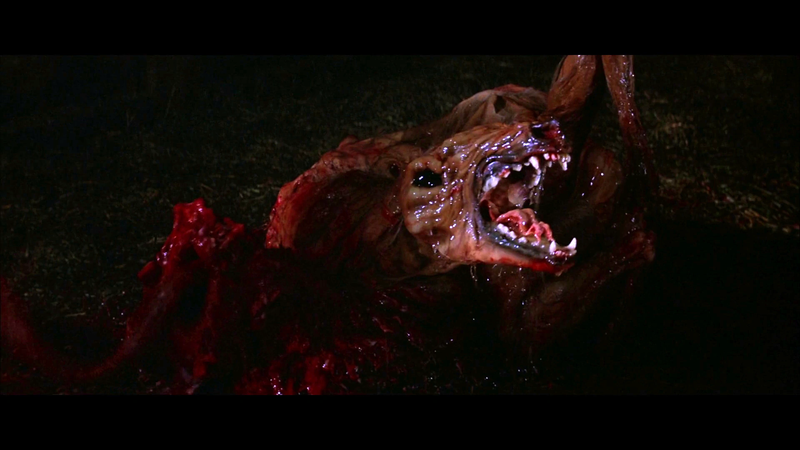
Not the dog!
"You see, what we're talking about here is an organism that imitates other life-forms, and it imitates them perfectly." ― Blair.
The earliest and most personal memories of horror movies were usually hearing about them secondhand from my dad, often on a Sunday morning over breakfast. "I watched this bloody 'orrible film last night…" he would say, firing up the imagination and prompting me to pry details out of him as he skirted around what happened to a dog's head and some guy's chest. Years later, I experienced The Thing for the first time ― far surpassing expectations ― and it became one of my "Holy Trinity." One of those obsessive films that leave an undeniable mark. You would be hard-pressed to choose a favorite Thing sequence, but our first introduction to the creature's grotesque ability displays one of the most stomach-churning moments in any horror.
We know something has been off with the dog from the beginning; its stilted and unnerving motions ― performed by "animal actor" Jed; a half-wolf, half-Alaskan malamute trained by his owner, Clint Rowe ― as it bides its time amongst the men. Eventually, guided to a kennel, it sits in perfect posture as we begin to hear an unnatural breathing sound. The rest of the pack is spooked even before the Dog-Thing reveals itself, its head peeling apart as the bloodied skull falls away, replaced with a thrashing appendage, which proceeds to spray streams of bile at the rest of the poor huskies. Affectionately referred to as the "meat-hole dog" by Team Bo-Teen, this first transformation and assimilation sequence not only shows us the horrific consequences of the Thing's actions but, upon the arrival of the men, how it makes every effort to survive, adapting immediately to the situation. The entire Kennel-Thing sequence is a masterclass not just in Bottin's planning of the effects but also in Dean Cundey's incredible cinematography who, to protect the illusion as much as possible, was careful how much was revealed. That said, despite Bottin's sensitivity over the lighting, even under a bright glare, Cundey still managed to elevate the effects and not give a single thing away.

Each build of the Dog-Thing was fabricated around complex mechanical components devised by physical effects veteran Roy Arbogast [8], sometimes needing up to seventeen technicians to operate. Evolving from the first iteration, spider-like limbs and malformed appendages burst from the dog's torso while tendrils latch onto one of the huskies in a beautiful use of reverse photography. Its mass alters again to reveal another mutated canine head; Stan Winston's "chicken-dog" puppet, which became a crucial contribution to the sequence after Bottin was hospitalized for almost two weeks from exhaustion. No surprise after working seven days a week, sometimes eighteen hours a day, for over a year while sleeping on the floors of sets and labs. Co-producer Stuart Cohen stated; "There was simply no template – creative, financial or otherwise – for what we were about to attempt … Rob was required to be a politician, enduring many pop 'inspections' from suspicious officials … with all this confusion and uncertainty, and with the pressure on (from John and others) to produce, it is in retrospect not hard to see why he ended up needing hospitalization." [9]
Wounded by shotguns, the Dog-Thing attempts to escape, large arms grabbing onto the ceiling, Bottin himself wearing the foam latex appendages for the insert shots. Again, a new main body was built as the mass reveals eyeballs and "Tongue-Flower" ― Bottin's "pissed-off cabbage" ― torched by Childs (Keith David) as it lunges towards him. When we come to its remains, Blair (Wilford Brimley) performs a second autopsy, and through closer observation ― eventually leading to his simulation (of assimilation) ― the threat to the rest of the world becomes apparent.
To make matters worse, it turns out that the Norwegian remains were simply dormant when Bennings (Peter Maloney) is attacked. The Thing digests its prey, not so much for sustenance but absorbs in its effort to replace, mimic, and, ultimately "imitate" its host. During this moment, we witness its (unfinished) version of a human being. As the Bennings-Thing stumbles out into the snow, the men bear witness to an uncanny parody of a man; monstrous hands revealed, mouth agape as a chilling alien siren hits the cold air before they set (what used to be) their colleague alight.
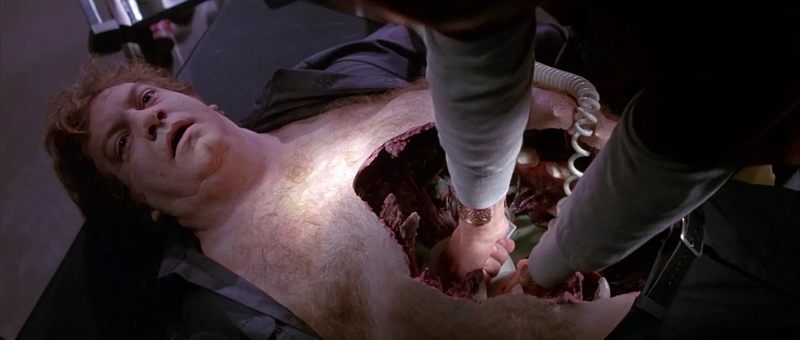
Chest pains… and worse
"You gotta be fuckin' kidding." ― Palmer
Arguably the standout moment is the Norris transformation during the defibrillator scene. Pushed to the absolute limits and ramping "things" up from Bill Lancaster's already taut script, Bottin, in dropping Ploog's initial responses ― tentacles erupting (goofily) from Norris's feet ― arrived at the idea of the "chest chomp". This unbearable moment links directly to Freud's castration anxiety that often rears its ugly head when discussing horror; specifically involving dismemberment. In The Monstrous-Feminine: Film, Feminism, Psychoanalysis, Barbara Creed highlights Joseph Campbell's own observations from Primitive Mythology, first published in 1959. This mythological motif is often seen in surrealist painting and the neurotic dream, presenting itself as the folkloric "toothed vagina" (vagina dentata). The organism at the center of The Thing isn't so much the personification of Mother Nature fighting back — its sexless and formless shape taking on an aggressive and horrific appearance — but simply a species attempting to survive. With this in mind, it is never on the attack (a problem with the 2011 prequel) but the offense. Its motivation is to hide within, revealing itself only when it needs to.

This graphic scene displays much of the imagery Creed analyzes. Summarized perfectly by writer Jez Conolly as the "monstrous life born of man"; he presents an in-depth analysis of the film, discussing further; "In some respects, the Norris-Thing sequence even more closely fulfills Creed's principle; not only do we have Norris' abdomen opening up to reveal a huge ghastly orifice, the savage teeth that emerge around the perimeter of the cavity 'castrate' Dr. Copper's penetrating forearms and a grotesque ossified parody of Norris projects upwards out of the chomping maw to cling to the ceiling, dripping with viscous fluid." [10] You could even go as far to say that there is a potent reminder of the classic Medusa imagery; the scene reminiscent of her decapitated head and serpentine writhing snake-hair
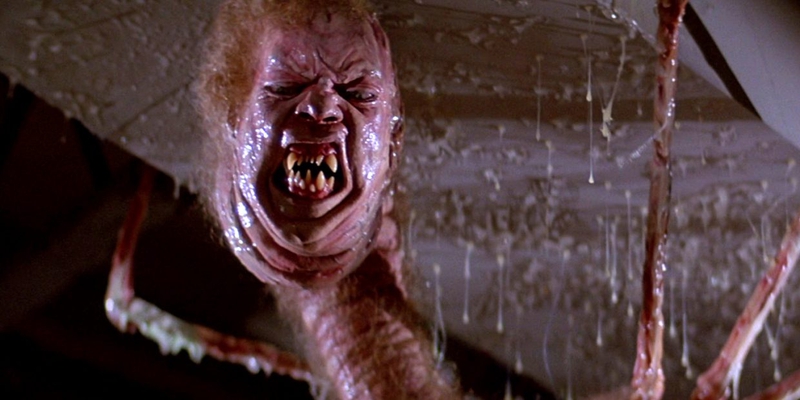
Analogy aside, this is a fierce sequence of events that only highlights the practicality of the setup. Effects technician Archie Gillett devised a false mechanical body for Norris actor Charles Hallahan, the inner armature made from fiberglass with foam latex skin and innards. Lethally, the teeth were molded in razor-sharp-edged acrylic, made all the more dangerous attached to a hydraulic ram that opened the chest cavity. One shot is of the mechanism severing gelatin arms and dental acrylic bones with blood tube inserts; the next, an amputee (Joe Carone) wore a look-a-like contorted mask of actor Richard Dysart (Copper). There is no time to question anything as the body erupts in a green explosion, one imitation — the "grotesque ossified parody" — attaching itself to the ceiling, the iconic image used for most video rental covers. They achieved this effect by constructing a marionette, operated predominantly by wires, with its head maneuvered through a hole in a false ceiling with radio-controlled facial expressions.
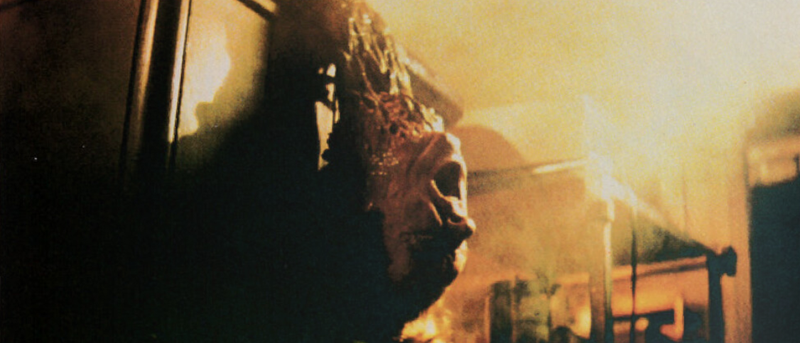
Norris' upturned head proceeds to tear itself from the torched body and pulls itself from view with its lashing tongue, then drags itself across the floor before sprouting spider legs and eyestalks. Based on Bottin's concepts, Gillet melded a combination of puppetry, cutaway floors for the final "Spider-Head-Thing" transformation, and what is essentially a radio-controlled car with legs… killed with fire.
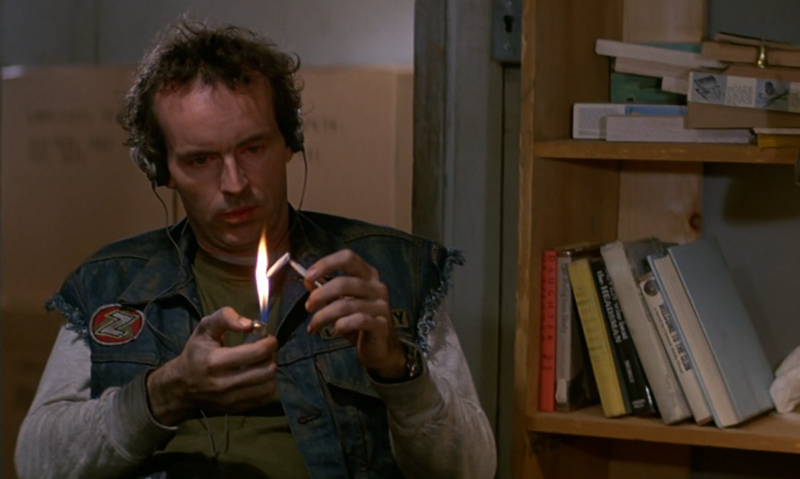
Every part a whole
"Ya see, when a man bleeds, it's just tissue…" ― MacReady
Suspicion, high tension, and intense paranoia (quite literally) come to a head during the blood test scene. Employing an ingenious example of practical effects, the "blood squeal" was an inflated (mini) monster mold popping from a hollow arm holding the petri dish that delivers the classic jump scare. This scene once again displays Cundey's use of subtle lighting; a gleam added to each actor's eye while Palmer (David Clennon) — devoid of the effect — is given less spark of (human) life with a dead-eyed expression. As MacReady works his way through the tests, there is the disturbing realization that their dog handler (he just shot through the head) wasn't an imitation, "Then Clark was human, huh? Which makes you a murderer, don't it?" retorts Childs. Gary (Donald Moffat) detracts further with a flippant comment before the alien escapes the hot wire, confirming the assimilated Palmer.
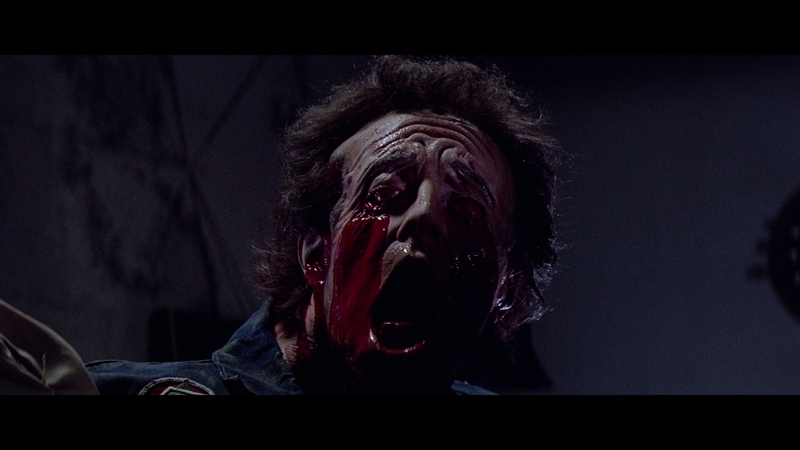

Dealt with once again by carefully planned stages of transformation, the Palmer-Thing was built using three separate puppets. The head swells — a combination of Bottin's "howling" air bladder work and shifting internal structure — then splits in half and grabs hold of Windows (Thomas G. Waites) with another lunging tentacle. The sheer panic caught on the screen reaches fever pitch as Windows' flailing body is tossed around like a rag doll; a torrent of fire follows more broken (bloodied) bodies. They compose themselves briefly and realize when checking in on Blair — locked up from his madness — he has now vanished after his own UFO "handiwork".
Originally devised as a stop motion animation by Randall William Cook — of which brief glimpses remain of its girth and tentacle grabbing the dynamite plunger — the "Blair-Thing" (or Blair-Monster) became the most challenging use of effects due to the range of motions the serpentine elements and facial expressions needed. The imposing mass of flesh reveals itself as a hellish totem of man, dog, and whatever other bastardized versions of things it has found along the way.

Blair's grotesque features, writhing limbs, and further body bursting activity was a frame of mechanisms skinned in 300 pounds of rubber, as well as urethane and fiberglass components laden with hoses of goop and gore. There is something finite in how it resembles a kind of distorted king (or queen) against a helpless pawn as MacReady, rather than chuck his whiskey over it, holds tight — "Yeah, fuck you too!" — then throws his stick of dynamite in another (explosive) chess move.

Cold comfort
"Why don't we just... wait here for a little while? See what happens." ― MacReady
The end — one of the greatest of all time — remains a mystery 40 years later. Carpenter makes no apologies for leaving his protagonists in question, nothing but the blazing outpost and a bottle between them. Is this a stalemate between two paranoid survivors? Or is at least one of them the Thing, happy to sleep in the ice for another 100,000 years? It all builds on its reputation, with final moments that perfectly reflect the ambiguity and mood already presented, right up to its bitter (frozen) climax. "'The story is scary, and then the monster is just the period at the end of the sentence (or exclamation point, as the case may be)." Stated Bottin, back in issue #21 of FANGORIA, "In other words, if The Thing is scary, it's the way John builds suspense.'"
A Lovecraft-infused masterpiece (with tenuous tendrils), this sci-fi horror continues to infect us all with its amorphous qualities, presenting a cold and twisted hell wreaking havoc on a "man's world". Here, in Antarctica, the female form is no bride of Frankenstein ― hysterical figure or victim ― but something closer to a nightmarish Mother Nature that consumes man. Through Bottin's ingenuity, we are presented with disturbing births as "things" split apart, contort, assimilate, mutate, manipulate and control; turning man into a carrier; a vessel… masculinity brought to its knees.
As with the men of Outpost 31, viewing the film becomes an intricate biological study that begins to reveal an unforgettable horror within. It crawls under our skin and infects us all, asking important questions about what it is to be human; how fear turns men into something monstrous and unrecognizable. We project our own fears onto this terrifying Thing ― obvious parallels to the current "climate of fear"; isolation and paranoia-fueled further by the scaremongering of parasites in vaccines ― and, through its grotesque imitation of life, also shows us how crucial it is to adapt and survive in this brutal world. All of these things not only prove the power of Carpenter's filmmaking and Bottin's benchmark practical effects but also how The Thing "transformed" horror movies forever.
For more of Rich's celebration of THE THING at 40, head on over to ARROW FILMS and read his recent piece, "The Top Ten Things We Love About The Thing".
- Arrow Video, The Thing Limited Edition booklet, "Some Thing Wicked This Way Comes…" (2017) by Violet Lucca pp.8.
- Allegorical grounds in science fiction, specifically "alien invasion", can be seen as far back as H.G. Wells' War of the Worlds (1898), his Martian threat a direct reference to the industrialization and colonialism of the period.
- FANGORIA issue #21 (August 1982), pp.13.
- Reasons for his "disappearance" and "reclusiveness" are speculative, ranging from fallouts to becoming jaded with the industry, poor health to now working in real estate.
- Carpenter via EFX Documentary Fantastic Flesh The Art of Make-Up (2008).
- Carpenter's film is more about male insecurities (castration anxiety and dangerous births); that only adds to the paranoia. A contrast to the "Hawksian woman", somewhat side-lined as a coffee gopher in the '50s version. Is the female a "cheatin' bitch”... or the Thing itself?
- The sign clearly says "United States National Science Institute 4" while "Outpost 31" ― referred to by most in the fanbase ― is in the script, Kuipers' concept art, and briefly mentioned by Windows as "US No. 31" as a call sign via the radio.
- An older professional who would tell Bottin straight that most of the effects had been done before. What was different here was how they achieved them for The Thing.
- Auteur Publishing, Devil's Advocates: The Thing by Jez Conolly, pp.68.
- Jez Conolly, pp.41.






